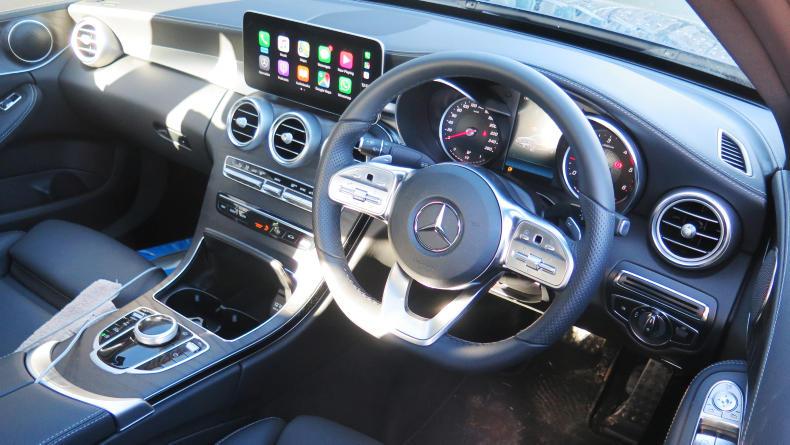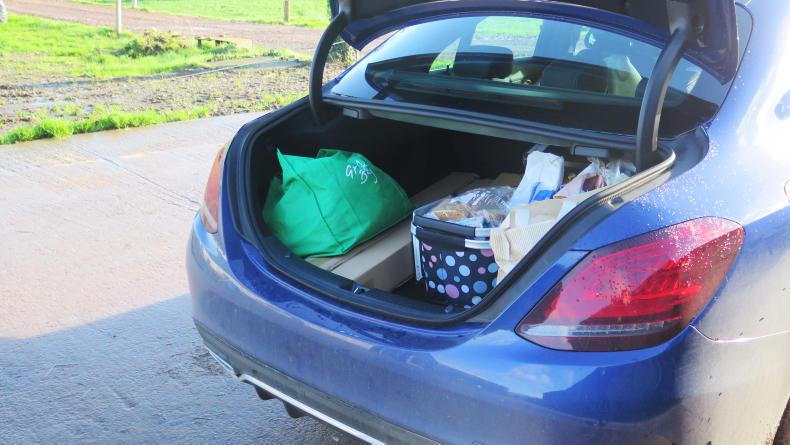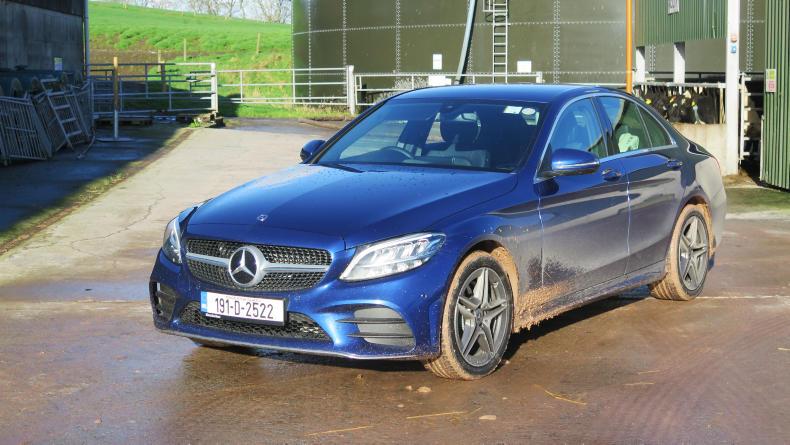You just can’t deny that luxury feel when you’re driving a Mercedes-Benz car. The sight of the badge alone seems to instinctively make us feel hard-wired to that luxury feeling.
Does it make us feel better about the brand? I certainly think so. Does it mean that the cars are better? Well that’s another story that we need to explore. I recently had the opportunity to do that in the new-generation Mercedes-Benz C-Class car.

For Mercedes-Benz, the C-Class range is now the second best-seller for the brand after the bigger E-Class. This is a mid-size car that I always equate to cars such as the Ford Mondeo and Volkswagen Passat in terms of size. Many people consider it a bigger car just because Mercedes-Benz is long established as a manufacturer of bigger cars, even though the smaller A-Class and B-Class models have been in the range for some decades now.
As a driver’s car, the new-generation Mercedes-Benz C-Class is true comfort. The level of comfort specification on these cars continues to rise and what is called a “seat comfort” is now a standard item.
Compared with the previous model, this new-generation C-Class introduced in 2018 comes with styling changes to the front and rear lights, as well as new bumper designs and a larger chrome-type grille that’s a shade more aggressive looking.

The dash area of the new Mercedes-Benz C-Class 200d combines a centre touchscreen with more conventional two-tube dial cluster between which there is a digital display screen.
On the inside, the most notable feature is the combination of a centre touchscreen with more conventional two-tube dial cluster between which there is a digital display screen. This differs from the wider screen featured in some of other models, including the new A-Class. This gives the C-Class a slightly more dated look while still being very functional.
I used the Apple CarPlay system in place of the Mercedes-Benz satnav system with centre touchscreen easily accessed. The screen quality is very clear, making the system pleasant to use.
The flat-end steering wheel comes with touch sensitive controls. I found that these take a little longer to get used to.
The C-Class retains the column shift for the automatic gearbox and blends that with an electronic handbrake. You quickly get used to the column shift system and it leaves the centre console free for the use of the rotary control unit.
The end result is still outstanding economy, putting the car well ahead of the competition
The Mercedes-Benz C-Class 200d is the second-up model in the range and is powered by a relatively small 1.6-litre turbo-diesel engine matched to a nine-speed automatic gearbox. That might seem too light in terms of power, but not so. Mercedes-Benz is getting 160bhp from this engine along with 360Nm of torque and that’s impressive. That’s measured by the rated acceleration figure of 7.9 seconds in a 0 to 100km/hr dash, which is fast for a car of this size with a modest engine.
Many other cars in this segment come with bigger 2.0-litre diesel engines, while Volkswagen offers a 1.6-litre diesel Passat option. For its engine size, this Mercedes-Benz C-Class is powerful and fast in a comfortable way. The automatic gearbox is standard and smooth to use, and there is ample power to propel the car across most road conditions with ease.

This new Mercedes-Benz C-Class 200d is powered by a 1.6-litre turbo-diesel engine that’s very smooth and delivers impressive economy through a nine-speed automatic gearbox.
This is confirmed by the ease of motorway cruising at 120km/h at just 1,750rpm on the engine. That performance delivered a range of almost 1,000km from the 66-litre fuel tank and that equates to a fuel consumption figure that’s almost 20% off the manufacturer rated figure.
The end result is still outstanding economy, putting the car well ahead of the competition. For me, that’s as big a desirability factor as the three-star badge, if not bigger.
What’s less to desire about is the space inside. This Mercedes-Benz C-Class is more compact that I had expected. Rear legroom is tight, and rear passengers might find the headroom tight. That should not be surprising as the car is significantly shorter than the likes of the Ford Mondeo, Opel Insignia and Volkswagen Passat. The car sits on a longer wheelbase than most of the others and that ensures good driving comfort, especially on smaller rural roads.
The boot space is also noticeably smaller at 455 litres. The boot lacks a spare wheel, always a negative for me. Overall, this new C-Class is a heavier car than some of the competition but lacks their towing ability coming in at just 1.8t with a braked trailer.

The boot on the Mercedes-Benz C-Class 200d is smaller than many of the competition at just 445 litres capacity.
I noted that this C-Class has a somewhat dated five-star Euro NCAP safety rating, while other cars in the range have more recent results. That might understate the fact that this is a very safe car with two Isofix mountings in the rear seats, but definitely not space for a third child seat.
Entry prices for the Mercedes-Benz C-Class 200d start from €42,840 or £34,960 in Northern Ireland, which is not much more expensive than similar specification cars from Volkswagen, Ford and Opel, two of which too have a German pedigree.
Many drivers might aspire to own a Mercedes-Benz C-Class and that comes dictionary-defined as a strong desire, which in turn is considered as an unsatisfied longing or craving. Mercedes-Benz has preserved that aspiration in the new C-Class, it is comfortable and very economical; just don’t expect it to be spacious.
You just can’t deny that luxury feel when you’re driving a Mercedes-Benz car. The sight of the badge alone seems to instinctively make us feel hard-wired to that luxury feeling.
Does it make us feel better about the brand? I certainly think so. Does it mean that the cars are better? Well that’s another story that we need to explore. I recently had the opportunity to do that in the new-generation Mercedes-Benz C-Class car.

For Mercedes-Benz, the C-Class range is now the second best-seller for the brand after the bigger E-Class. This is a mid-size car that I always equate to cars such as the Ford Mondeo and Volkswagen Passat in terms of size. Many people consider it a bigger car just because Mercedes-Benz is long established as a manufacturer of bigger cars, even though the smaller A-Class and B-Class models have been in the range for some decades now.
As a driver’s car, the new-generation Mercedes-Benz C-Class is true comfort. The level of comfort specification on these cars continues to rise and what is called a “seat comfort” is now a standard item.
Compared with the previous model, this new-generation C-Class introduced in 2018 comes with styling changes to the front and rear lights, as well as new bumper designs and a larger chrome-type grille that’s a shade more aggressive looking.

The dash area of the new Mercedes-Benz C-Class 200d combines a centre touchscreen with more conventional two-tube dial cluster between which there is a digital display screen.
On the inside, the most notable feature is the combination of a centre touchscreen with more conventional two-tube dial cluster between which there is a digital display screen. This differs from the wider screen featured in some of other models, including the new A-Class. This gives the C-Class a slightly more dated look while still being very functional.
I used the Apple CarPlay system in place of the Mercedes-Benz satnav system with centre touchscreen easily accessed. The screen quality is very clear, making the system pleasant to use.
The flat-end steering wheel comes with touch sensitive controls. I found that these take a little longer to get used to.
The C-Class retains the column shift for the automatic gearbox and blends that with an electronic handbrake. You quickly get used to the column shift system and it leaves the centre console free for the use of the rotary control unit.
The end result is still outstanding economy, putting the car well ahead of the competition
The Mercedes-Benz C-Class 200d is the second-up model in the range and is powered by a relatively small 1.6-litre turbo-diesel engine matched to a nine-speed automatic gearbox. That might seem too light in terms of power, but not so. Mercedes-Benz is getting 160bhp from this engine along with 360Nm of torque and that’s impressive. That’s measured by the rated acceleration figure of 7.9 seconds in a 0 to 100km/hr dash, which is fast for a car of this size with a modest engine.
Many other cars in this segment come with bigger 2.0-litre diesel engines, while Volkswagen offers a 1.6-litre diesel Passat option. For its engine size, this Mercedes-Benz C-Class is powerful and fast in a comfortable way. The automatic gearbox is standard and smooth to use, and there is ample power to propel the car across most road conditions with ease.

This new Mercedes-Benz C-Class 200d is powered by a 1.6-litre turbo-diesel engine that’s very smooth and delivers impressive economy through a nine-speed automatic gearbox.
This is confirmed by the ease of motorway cruising at 120km/h at just 1,750rpm on the engine. That performance delivered a range of almost 1,000km from the 66-litre fuel tank and that equates to a fuel consumption figure that’s almost 20% off the manufacturer rated figure.
The end result is still outstanding economy, putting the car well ahead of the competition. For me, that’s as big a desirability factor as the three-star badge, if not bigger.
What’s less to desire about is the space inside. This Mercedes-Benz C-Class is more compact that I had expected. Rear legroom is tight, and rear passengers might find the headroom tight. That should not be surprising as the car is significantly shorter than the likes of the Ford Mondeo, Opel Insignia and Volkswagen Passat. The car sits on a longer wheelbase than most of the others and that ensures good driving comfort, especially on smaller rural roads.
The boot space is also noticeably smaller at 455 litres. The boot lacks a spare wheel, always a negative for me. Overall, this new C-Class is a heavier car than some of the competition but lacks their towing ability coming in at just 1.8t with a braked trailer.

The boot on the Mercedes-Benz C-Class 200d is smaller than many of the competition at just 445 litres capacity.
I noted that this C-Class has a somewhat dated five-star Euro NCAP safety rating, while other cars in the range have more recent results. That might understate the fact that this is a very safe car with two Isofix mountings in the rear seats, but definitely not space for a third child seat.
Entry prices for the Mercedes-Benz C-Class 200d start from €42,840 or £34,960 in Northern Ireland, which is not much more expensive than similar specification cars from Volkswagen, Ford and Opel, two of which too have a German pedigree.
Many drivers might aspire to own a Mercedes-Benz C-Class and that comes dictionary-defined as a strong desire, which in turn is considered as an unsatisfied longing or craving. Mercedes-Benz has preserved that aspiration in the new C-Class, it is comfortable and very economical; just don’t expect it to be spacious.














SHARING OPTIONS